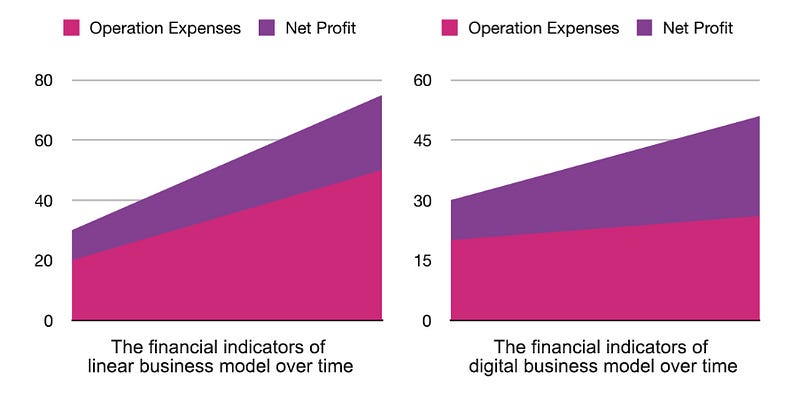By Anadea
IT outsourcing is one of the most commonly-used strategies by which technology-driven businesses control operating costs without sacrificing the quality of their core product.
“Why businesses outsource” is a topic that comes up over and over. While the idea of outsourcing may seem like something of an old story, the way in which clients approach partnerships with IT service providers is changing rapidly. This change, in large part, reflects the evolution of providers from companies selling purely technical solutions according to client needs into firms with wide experience across different domains of the software development ecosystem. At Anadea, we’ve observed that many of our new clients sought our partnership primarily due to our multidisciplinary expertise, which allows us to advise clients on how to best make the transition from what I call a “linear business model” to a “digital” one. I’ll return to these concepts shortly.
First, though, I’d like to suggest two main reasons for why clients are more interested in holistic solutions than myopic ones.
- We have reached a point of technological progress in which it is easier than ever to facilitate communication between multiple systems, services, or platforms. Thanks to concepts like microservice architecture and REST, we are, to a great extent, liberated from a strict adherence to individual technology stacks or development paradigms.
- Many businesses no longer see bespoke software as inherently valuable. While, in the past, companies may have seen software as a way to automate routine human processes, they now see it as a way to fundamentally transform core business process. In other words, they see it as a way to “go digital.”
How businesses operate: from a linear model to digital one
On its own, the automation of business processes can help companies become more effective by reducing operational expenses and delivering better client experiences. That being said, an exclusive focus on process optimization can yield only linear growth, as the benefit derives from the marginal performance improvement of each process. Put another way, the higher the “Amount of Operations,” the more revenue the company gets. The problem with this strategy is that it is difficult to scale, and may thus produce a new set of inefficiencies that will have to be dealt with.
Another approach is to start thinking digitally. While the idea of “going digital” has clearly found its way into the zeitgeist — indeed, the expression alone is suggestive enough to produce visions of enhanced profit margins in the heads of C-level executives — it can be difficult to pin down exactly what it means. Put broadly, digitalization allows a company to grow a client network, increase sales, or control operational expenses in a way that is independent of the “Amount of Operations” its employees can execute. The value of digitalization is not marginal, but rather exponential.
The illustrations below demonstrate the differences between Linear and Digital models.

Having seen the benefits of switching from a linear model of business operations to a digital one, it follows that the next question we need to tackle is how a company can actually achieve this transformation.
Perhaps not surprisingly, the change from a linear to a digital business model starts with a fundamental change in the way we understand the relationship between routine business processes and software.
Whereas in linear model, we ask ‘how can this software improve a routine operation that has already established?,’ in a digital model we start by posing the question, ‘how can software directly add value to my business?’
Companies which have already adopted this philosophy have a noticeably different relationship with IT service providers than those that still adhere to the ‘linear’ model. Followers of the ‘digital’ model are more likely to focus on questions like “what kind of solutions have you already built for my business sector” or “how can we achieve what we want using software.” They are less concerned with the nitty-gritty details of implementation than on the achievement of their broader goals.
‘Digital’ companies differ from their ‘linear’ counterparts in another important way — while the latter see service providers primarily as vendors for discrete technical services, the former see them as knowledgeable partners who will support them through their digital transformation.
The world is continuously changing, and having a ‘digital buddy’ is essential if a business wants to go digital.
Conclusion
We’ve talked a lot in this article about the difference between linear and digital businesses, and about how the latter have a tremendous opportunity to benefit from technological innovation and strategic partnerships with IT service providers. However, what can we say about the future of the providers themselves?
First, we can be sure that, as the business environment changes, IT service providers will continue to change with it, becoming collections of domain experts knowledgeable in each step of the software development lifecycle. Every single person in the service company knows what they are doing, what the client’s needs are, and how the client plans to utilize the company’s product or services to improve its business. While technical skill remains a crucial component of the provider’s offerings, in-depth knowledge of how their clients’ businesses work is just as important. When an IT service provider combines these two qualities, you can be sure they are capable of helping you make the transformation to a digital company.
The second aspect is to be ready to serve the clients who invited you to their digital transformation journey.
So, how then the next generation of IT service company will look like. First of all, it will be the company of domain experts across the whole delivery flow: starting from client relationship managers and finishing engineers. Besides, every single person of the service company knows what they are doing, what the client’s needs are and how client is going to use their software.
source: medium.com












